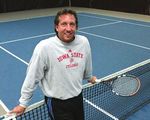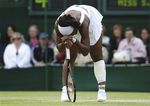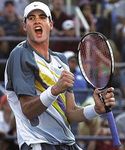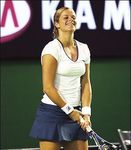Doubles Partners: Common Lower Extremity Tennis Injuries
←
→
Page content transcription
If your browser does not render page correctly, please read the page content below
C U RRE N T TO P I C S I N S P O RTS P O D I ATRY
Doubles Partners:
Common Lower
Extremity Tennis Injuries
You’ll find these on the professional tour and in your community.
By Alex Kor, DPM, MS ing the Bryan brothers, Stan Smith Williams, Gil Schuerholz and Kim
and Bob Lutz, John McEnroe and Clijsters, Daniela Hantuchova and
This article is provided exclusively to Peter Fleming, Martina Navratilova Ken Barnas, Jordan Corey and
Podiatry Management by the American and Pam Shriver, etc. These partners Rafael Nadal, and Alex Kor and
Academy of Podiatric Sports Medicine. selected each other because their John Isner are NOT “household
The AAPSM serves to advance the un- styles complemented the other names.” They would not strike
derstanding, prevention and manage- player and usually the “sum of its much fear in the hearts of the
ment of lower ex-
tremity sports
and fitness in-
juries. The
Academy believes
that providing
such knowledge
to the profession
and the public
will optimize en-
joyment and safe
participation in
sports and fitness
activities. The
Academy accom- Figure 1
plishes this mis-
sion through professional education, sci- parts is greater than the whole.” world’s best. But for purposes of
entific research, public awareness and The game of tennis is a very this article, these doubles “part-
membership support. For additional in- physically demanding activity. The ners” have been created because
formation on becoming a member of the ballistic nature of the sport that in- each “team” has been affected by a
AAPSM please visit our website at volves sudden stops, starts, lateral similar lower extremity injury.
www.aapsm.org or circle #151 on the movements, jumping, quickness,
reader service card. speed, etc., lends itself to lower ex- Calf Injuries
tremity injuries. Whether you are
S
ingles play receives publicity, competing for a local USTA team or Doubles Team #1—Serena
notoriety, and fanfare on the trying to win a third round match Williams and Gregg Wollard
Association of Tennis Profes- at the French Open, injuries are ob- (Figure #1)
sionals (ATP) and the Women’s stacles that ALL tennis players are At the July 2007 Wimbledon
Tennis Association WTA) tours as trying to avoid. Once such an in- Championships (in the fourth
well as at every level of the United jury is encountered, regardless of round), Serena Williams, the for-
States Tennis Association (USTA). the level, his or her play will be ad- mer #1 female player in the world,
But many would argue that the versely affected. suffered a calf injury that contribut-
game of doubles involves more ed to her eventual loss in the next
strategy, intrigue and competition. Fictional Doubles Teams round to Justine Henin. The same
Over the years, there have been The fictional doubles teams of week, Gregg Wollard, a 43 year old
many great doubles partners includ- Gregg Wollard and Serena Continued on page 92
www.podiatrym.com APRIL/MAY 2011 • PODIATRY MANAGEMENT 91Tennis Injuries... play the next round after her in- On Aug. 14th, 2009, Gil felt a
jury. But a Grand Slam title was at “snap, crackle and pop” within his
airport engineer from Reston, Vir- stake. On the other hand, Gregg left heel while playing in a USTA
ginia sustained the same injury. was NOT battling to stay at the top team tournament. He attempted to
Having a history of a previous of the world rankings. He was play the remainder of the event,
Achilles tendon rupture four years “sidelined” for six weeks, did not but could not continue. For one
previously, Gregg promptly discon- require surgery, and successfully re- week, he utilized frequent ice appli-
tinued his 4.0 USTA tennis match. turned to the courts of northern cations, an over-the-counter orthot-
He was unable to walk, and was im- Virginia. ic, and did not play. With the Na-
mediately concerned that he would tional 45 and over Grass Courts
need more surgery. Thus, whether Rupture of the Plantar Fascia slated to start on August 23rd,
you are a world class player or a 2009, Gil was unsure if he could
local player trying to win a league Doubles Team #2—Kim play singles and doubles. He and
match, this injury can hamper any Clijsters and Gil Schuerholz his partner (Andy Stoner) had en-
tennis player. (Figure #2) joyed previous success by winning
In order to understand the de- Most tennis fans are aware that the 2008 45 and over Indoor Dou-
gree of injury that Serena and Kim Clijsters, from Belgium, is one bles Championship. But playing on
Gregg experienced that summer, it a partially ruptured plantar fascia
is essential to review the anatomy was not the ideal scenario for any
of the calf and etiology of the in- player, including Gil Schuerholz.
jury. The calf musculature is com-
prised of the gastrocnemius muscle
(more superficial and larger) and
the soleus muscle (deeper). These
two structures then join to com-
prise the Achilles tendon which at-
taches into the back of the calca-
neus. When the foot is dorsiflexed
during an impact activity, the two
calf muscles will become taut. If the
knee straightens during this mo-
ment, the gastrocnemius may be-
come so taut that a strain, or a par-
tial tear or a rupture may occur. Figure 2
This calf injury, known as “tennis
leg”, most commonly affects the of only a few mothers to be playing When any athlete tears a por-
medial head of the gastrocnemius on the WTA tour. After a two-year tion of the plantar fascia, the usual
muscle. absence (to have her baby), Kim re- presentation is localized erythema,
turned to win the 2009 U.S. Open edema, echymosis, intense pain,
Tennis Leg in New York City. But not many and difficulty in full weight-bear-
The treatment for “tennis leg” observers know ing. As with “ten-
depends on the severity of the in- that on two sepa- nis leg”, a defect
jury. Most players will respond to rate occasions, can be palpated
three to six weeks of rest, frequent Kim has sustained The ballistic nature of within the fascia.
ice applications, no heat (unless a partial rupture X-rays and an
the player wants to “warm up” the of the plantar fas- the sport that involves MRI will rarely
muscle before playing), compres- cia, and eventual- sudden stops, starts, alter the initial
sion of the calf, and a heel lift (to ly returned to the therapy. If the
reduce tension along the gastroc- court. Gil Schuer- lateral movements, athlete does not
nemuis/soleus complex) in the holz, a 47 year desire to return to
shoe(s). Depending on the athlete’s old local tennis
jumping, quickness, play and the fas-
skill level, motivation, pain thresh- professional from speed, etc., lends itself cial rupture is ex-
old, and other factors, the response Ellicot City, tensive, the best
to treatment varies. Examination Maryland will ob- to lower extremity treatment would
of the injured site will, at times, re- viously never be include: no im-
veal a palpable defect near the me- able to fully ap-
injuries. pact activity for
dial head of the gastrocnemius. A preciate the de- six to eight weeks,
MRI may allow for better visualiza- mands of child a weight-bearing
tion and, in very elite players, may birth. But based upon his 2009 ex- boot for six weeks, soft tissue mas-
provide more information in order periences, Gil can indeed appreciate sage, ice, physical therapy, and cus-
to predict when the tennis player how tough it is to return to playing tom made orthotics.
can return to the court. In 2007, tennis after injuring one’s plantar If the athlete (like Gil) is moti-
Serena unsuccessfully attempted to fascia. Continued on page 94
92 PODIATRY MANAGEMENT • APRIL/MAY 2011 www.podiatrym.comTennis Injuries... forward toward the net. As he was cast for twelve weeks, followed by a
about to hit a volley, he felt as if below-the-knee cast for four weeks.
vated to play and can tolerate pain, the back of his right lower leg had By early 2004, Ken was able to begin
the protocol can be drastically dif- “exploded.” His first thought was physical therapy. Although he was
ferent, and is accelerated in an ef- that someone’s racket had struck eager to return to the court, he did
fort to get the athlete playing ten- the back of his leg and ankle. But not begin playing until June 2004.
nis. In Gil’s situation, he was unable to One can only hope that Daniela is
he decided to not play stand and forced to not “sidelined” for as long as Ken was
singles and to concen- default. in 2004.
trate only on doubles at Generally,
the National Grass when an athlete Lower Leg and Knee Injuries
Courts. After the first
seven days of inactivi- Doubles Team #4—Rafael
ty, Gil attempted to get Nadal and Jordan Corey
ready for the doubles (Figure #4)
competition which The “doubles team” of Jordan
started on August. Corey, a 36 year old Seattle-based
26th. On a daily basis, financial analyst and Rafael Nadal,
his foot was taped, had the number one player in the
cross friction soft tissue world, have both battled lower leg
massage, he began to and knee pain. Although Rafa has
stretch, and his pain enjoyed more success, both play
gradually improved. Al- the game of tennis with “reckless
though Gil and his Figure 3 abandon.” And, without doubt,
partner lost a set in their grinding, “never give up”
their first round match, they tears the Achilles tendon, there is styles have contributed to these
emerged victorious, despite his no ability to plantar-flex the affect- overuse injuries.
heel being very sore. Using grit and ed ankle (a positive Thompson’s Rafael Nadal’s foot problems
determination, they managed to test). The exam finds a disruption began in 2004 when he developed
advance to the finals. or attenuation of the substance of a stress fracture. Many so-called
Fifteen days after partially tear- the Achilles tendon, edema, echy- “experts” said that this would
ing his plantar fascia, Gil Schuer-
holz and Andy Stoner won the
2009 45 and over Grass Court
Doubles crown. This compares
favorably to a study by Saxena
and Fullem 1 that followed 18
athletes who returned to their
athletic activity at approximate-
ly 9.1 +/- 6.0 weeks. One can as-
sume that even Kim Clijsters
would have been impressed with
Gil’s effort.
Achilles Tendon
Figure 4
Doubles Team #3—Daniela
Hantuchova and Ken Barnas mosis, pain, and inability to apply plague him for the rest of his ca-
(Figure #3) weight. X-rays can be ordered to reer. Yet he went on to win the
The Achilles tendon is a com- rule out bony pathology, and an French Open from 2005–2008. But
mon site for pain in many tennis MRI can confirm the clinical pic- in the last two to three years, a ma-
players. The spectrum of pathology ture. Although conservative treat- jority of Rafa’s injuries are occur-
can range from Achilles tendonitis ment is an option for a more seden- ring proximal to the foot. Al-
to a rupture. Daniela Hantuchova, tary patient, surgical repair of the though he won the 2010 French
a 27 year old Slovakian, initially torn tendon is the treatment of Open, Wimbledon and U.S. Open,
had Achilles tendonitis but had to choice for any athlete hoping to re- shin splints, patellar tendonitis, a
withdraw from this year’s Aus- turn to sports. knee injury and, most recently,
tralian Open when an MRI re- Ken Barnas, a nationally ranked hamstring issues have affected his
vealed a tear. Ken Barnas, a 51 year player, had every intention to return play.
old business owner from LaPlata, to his beloved hobby. Less than two Jordan began to have pain on
Maryland, was in the midst of a days after his rupture, Ken under- the lateral aspect of the left knee in
match in August of 2003 when he went successful surgical repair. Post- 2009. This pain was reproduced
hit a service return and took a step operatively, he was in a full length Continued on page 96
94 PODIATRY MANAGEMENT • APRIL/MAY 2011 www.podiatrym.comTennis Injuries... author, suffered a similar injury ability to apply weight. Per the Ot-
while playing a doubles match on tawa ankle rules, X-rays are NOT
after playing multiple days in a row July 14th, 2008. During a “heated” always necessary for a suspected
and improved with rest. After see- exchange” at the net, a lob was hit ankle sprain, but are usually or-
ing his primary over my head. As dered for athletes. As with most
care physician, I was making acute injuries, the regimen of rest,
Jordan was sent contact with the ice, compression, and elevation is
to a physical ther- The calf injury, ball, my left foot suggested. If the athlete does not
apist whose eval- and ankle invert- respond in a sufficient period of
uation revealed known as “tennis leg”, ed, and I fell to time, more advanced studies (MRI)
ilio-tibial band the ground in are recommended. Other treat-
syndrome. This is
most commonly pain. Using a ments include physical therapy
an inflammation affects the medial compression modalities, NSAIDs, ankle braces,
of a band of tis- dressing, I was cortisone shots, orthotics, etc.
sue that extends head of the able to complete
from the lateral gastrocnemius the match. Unfor- Summary
aspect of the tunately, we were According to a review article
pelvis to the later- muscle. not victorious. by Bylak J. and Hutchinson, 4 ju-
al aspect of the The pain and nior tennis players are two times
knee. Pat Wempe, swelling contin- more likely to injure the lower ex-
PT, 2 a physical ued for the re- tremity than the upper extremity
therapist in Evansville, IN, specu- mainder of the month of July. X- or spine. And, regardless of age,
lates that poor muscular control
of the hip external rotators can
play a role. Jordan’s treatment
consisted of aggressive physical
therapy, soft tissue massage, a
home stretching program, and
custom-made orthotics. At last re-
port, on the hard courts of Seattle,
Jordan is playing pain-free tennis
but (unfortunately) has not cap-
tured any major titles (as Rafa has)
since his injury.
Ankle Injuries
Figure 5
Doubles Team # 5—John Isner
and Alex Kor (Figure #5) rays were normal. But by early Au- we already know that an ankle
John Isner, who stands 6’9”, is gust I was asymp- sprain is the most
an American tennis player who is tomatic and grad- comm on a cute
most famous for winning the ually returned to injury in tennis.
longest match in tennis history. At playing. When any Thus, one can as-
the 2010 Wimbledon, he beat According to sume that all ten-
Nicholas Mahut, 70-68 in the fifth a paper in the athlete tears a ni s pla yers,
set of their first round match. But British Journal of portion of the y oung a n d ol d,
John may be more proud that he Sports Medicine 3 m ust comb at
was able to play his first round in 2006, ankle plantar fascia, the lower extremity
match at the 2010 U.S. Open after sprains account- injuries. A blister,
sustaining a severe ankle sprain only ed for 20–25% of usual presentation is corn, callus, sub-
two weeks before. On August 18th, all acute injuries localized erythema, u n g u a l
2010, while playing a match at the on a tennis court. hematoma, and
Cincinnati ATP tour stop, he was By definition, an edema, echymosis, an ingrown toe-
forced to default his match after the ankle sprain is an nail m ay caus e
injury. His playing status at the acute soft tissue
intense pain, and pain but are un-
2010 U.S. Open was questionable, at injury that results difficulty in full likely to prevent
best. But on Sept. 2nd, 2010, he in damage to the any m otiva ted
miraculously won his first match at ligaments, ten- weight-bearing. tenni s pla yer
the U.S. Open. Despite an MRI that dons, and associ- from b eing on
showed no fracture but significant ated soft tissues the court. How-
ligament damage, he was able to of the ankle. Typ- ever, other foot
win two rounds in the tourney. ically, the athlete will experience and ankle maladies such as a neu-
Five-foot-seven Alex Kor, your immediate pain, swelling, and in- Continued on page 98
96 PODIATRY MANAGEMENT • APRIL/MAY 2011 www.podiatrym.comTennis Injuries... of the plantar fascia, or a more Dr. Alex Kor
proximal injury (e.g. ilio-tibial has a BS in
roma, metatarsalgia, stress frac- band syndrome), or a tear of the Chemistry from
ture, tendonitis, etc. may indeed Achilles tendon, or a severe ankle Butler Universi-
ty and an MS in
result in a longer lay-off. If the in- sprain, all tennis players can miss
Exercise Physi-
juries that our “doubles partners” a majority of a season when con-
ology from Pur-
fronted with these significant in- due University.
juries. However, once all of our He received his
“doubles teams” are again healthy, DPM degree
Generally, this tennis-playing podiatrist will from the Dr.
when an athlete welcome the opportunity to battle William M. Scholl College of Podi-
any of the other “teams” as long atric Medicine in Chicago. In 1990,
tears the Achilles as his partner, John Isner, serves Dr. Kor completed a Podiatric Surgi-
first. ■ cal Residency at Westside V.A. Medi-
tendon, there is cal Center—University of Illinois. He
has served as the team podiatrist at
no ability to References the N.C.A.A. Division I level (Univer-
1
Saxena A, Fullem B. Plantar fascia sity of Evansville), the NCAA Division
plantar-flex the ruptures in athletes. American Journal II level (Bowie State University in
of Sports Medicine. 2004; April—May,
affected ankle 32(3): 662-5.
Bowie, MD) and at the NCAA Division
III level (Knox College in Galesburg,
(a positive
2
Wempe P. Personal Communica- IL).
tion. Jan. 2011. Kor is certified by the American
Thompson’s test). 3
Van Zoest WJ, Janssen RP, Tseng Board of Podiatric Surgery and is a
CM. An uncommon ankle sprain. Fellow of the American Academy of
British Journal of Sports Medicine. Podiatric Sports Medicine. In addition
2007; Nov. 41(1): 849-50. to his current duties at Bowie State
sustained are again examined, it is 4
Bylak J, Hutchinson MR. Com- University, In 2010, Dr. Kor was the
clear that whether you sustain a mon sports injuries in young tennis #59 ranked men’s singles tennis play-
strain of the medial head of the players. Sports Medicine. 1998; Aug. 26 er in the 45-and-over age group in the
gastrocnemius or a partial rupture (2):119-32. United States.
98 PODIATRY MANAGEMENT • APRIL/MAY 2011 www.podiatrym.comYou can also read



























































